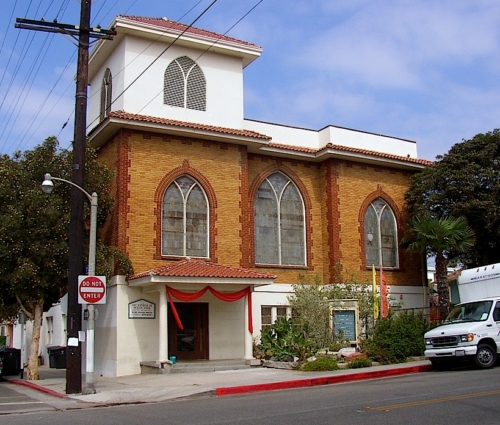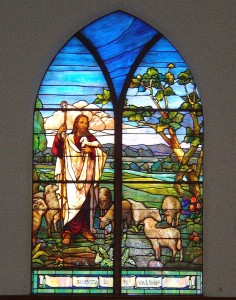The Church in Ocean Park

- Known As
- Third Street Neighborhood Historic District, Gothic, American Colonial, Italianate
- Architect
- James T Peasgood
- Built
- 1923
- Designated
- 1990
The early 1920s was a time when architects sought inspiration in past historical models, giving rise to Period Revival styles. However, their interpretations could be very creative, as exemplified in this building, which draws upon Gothic, American Colonial and Italianate precedents. The pointed windows are Gothic; the columned portico American Colonial; and the square corner tower, prominent cornice and use of contrasting brick accents on the corners and windows are Italianate. The architect of the building was James T. Peasgood, a church member. A stained glass window dedicated to him is found at the top of the stair landing.
The original church, the Ocean Park Methodist Episcopal Church, now stands to the north. It has been converted to a residence and is open for the Third Street Historic District Tour.
The Church in Ocean Park also owns the two adjacent historic wood frame homes on Hill Street. The cottage parsonage at 237 Hill was moved here from Third and Beach Streets. The Archer House at 245 Hill was built in 1898 and was owned by people prominent in the history of Ocean Park. All three structure contribute to the significance of the Third Street Historic District.
The simple and unpretentious design of the brick church reflects Midwest precedents for Methodist churches. Indeed, the plans even include a door marked “snow door”.
Today, in addition to church services, the building is used for a wide variety of community activities, child-care, cultural events, classes, meetings, and more. The original altar and stairs are inside of the new platform stage.
Its most outstanding architectural feature is the stained glass windows. Most of them are decorative, consisting of pictorial medallions set into opalescent glass with green and purple glass frames. Two are representational, both scenes from the life of Jesus: Christ the Good Shepherd, and Christ in the Garden of Gethsemane. These window are of the highest artistic quality, in design and craft. Rich coloristic treatments result from multiple layers of glass, and paint is also used over the stained glass. Although resembling Tiffany windows, the artist behind these windows is not known.
Other original features inside are the wood wainscot, the stage proscenium, the ceiling light fixtures and decorative rosettes, and the Mission-style chairs now placed along the wall. A side room, used originally for the Sunday School, also has noteworthy stained glass.
